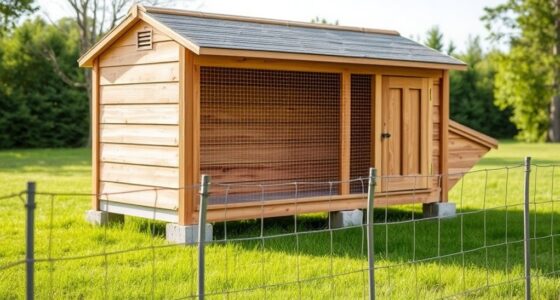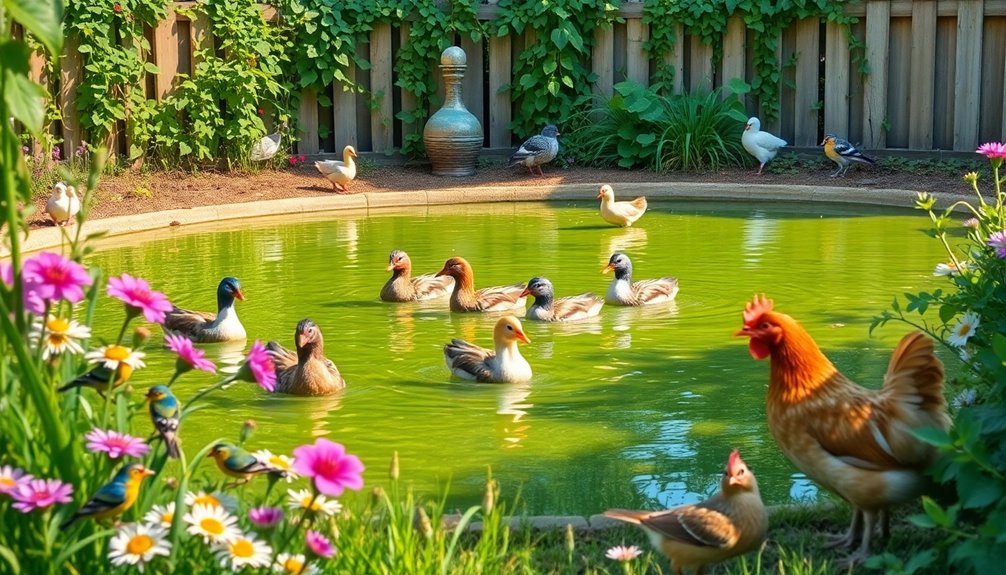Geese are excellent guardians for your livestock thanks to their natural instincts and strong bonds. They're territorial, using loud honking and aggressive displays to ward off intruders. By imprinting on a flock, they develop loyalty and become vigilant protectors. Choosing the right breed, like African or Chinese geese, can enhance their guarding abilities. However, keep in mind their limitations, especially at night. Want to know more about maximizing their effectiveness as protectors?
Key Takeaways
- Geese have a strong natural guarding instinct, deterring intruders with loud honking and aggressive displays.
- Imprinting on a flock enhances geese's protective instincts, making them more responsive to threats.
- Choosing the right breed, such as African geese for larger properties, is crucial for effective livestock protection.
- Geese are vigilant guardians during the day but are less effective at night due to poor visibility.
- Multiple geese are needed for adequate protection, as a single goose may prioritize its safety over that of livestock.
Natural Guarding Instinct of Geese
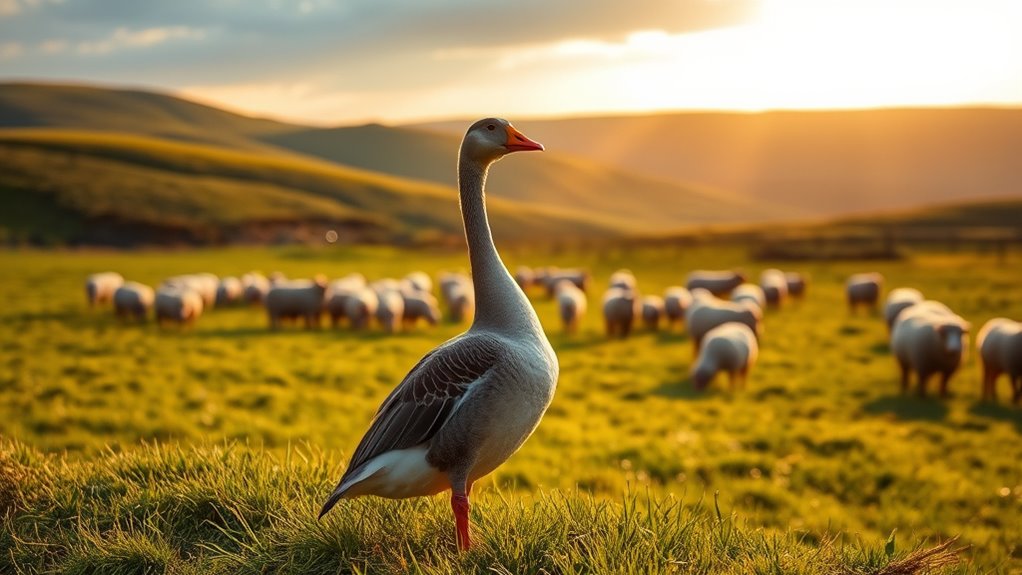
Geese possess a natural guarding instinct that makes them formidable protectors of their territory. Their territorial behavior shines during mating and hatching seasons, as they aggressively defend their nesting areas.
To deter intruders, geese employ loud honking, hissing, and wing-spreading. If these threat displays fail, they won't hesitate to attack using their strong beaks and wings. With superior distance vision, they can spot predators from afar, enhancing their vigilance.
Geese also travel in flocks, providing safety in numbers and shared responsibility for guarding. When nesting, they choose concealed locations for added protection, with both parents actively defending the nest.
Their innate instincts ensure they effectively protect livestock and other valuable assets without requiring any training.
The Importance of Imprinting and Bonding
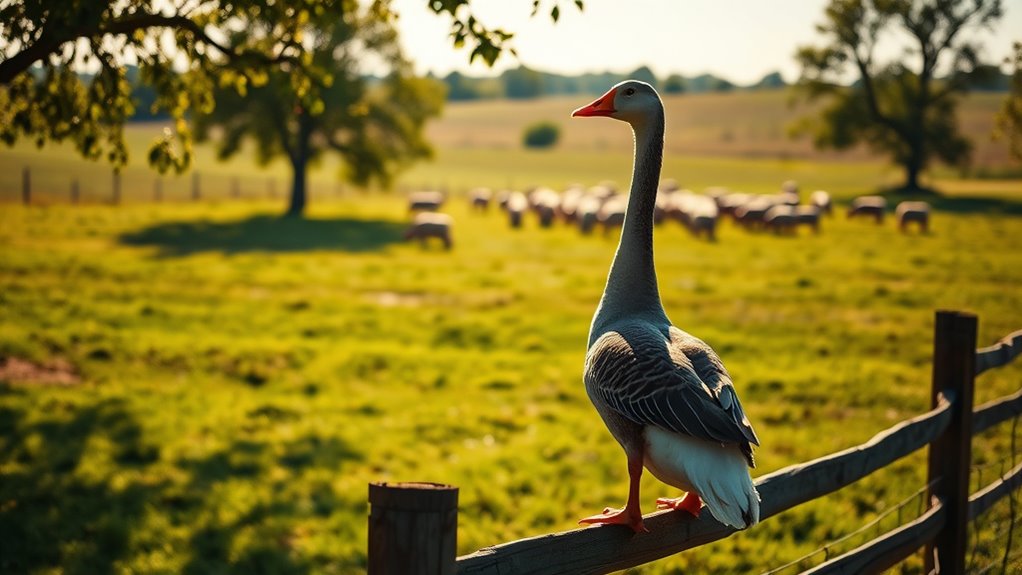
When raising guard geese, understanding the importance of imprinting and bonding is crucial for their effectiveness in protecting livestock.
Imprinting occurs when young geese form a strong bond with the first moving object they see, often leading them to consider humans or other animals as family. By imprinting geese on your flock, you enhance their protective instincts, making them more vigilant and responsive to potential threats.
Integrating goslings with chickens or ducks fosters a strong connection, promoting a sense of duty towards their imprinted flock. With a single guard goose per flock, you'll achieve optimal bonding, ensuring they actively defend and alert you to dangers.
This lifelong bond shapes their loyalty and effectiveness in guarding your livestock.
Understanding Territorial Behavior
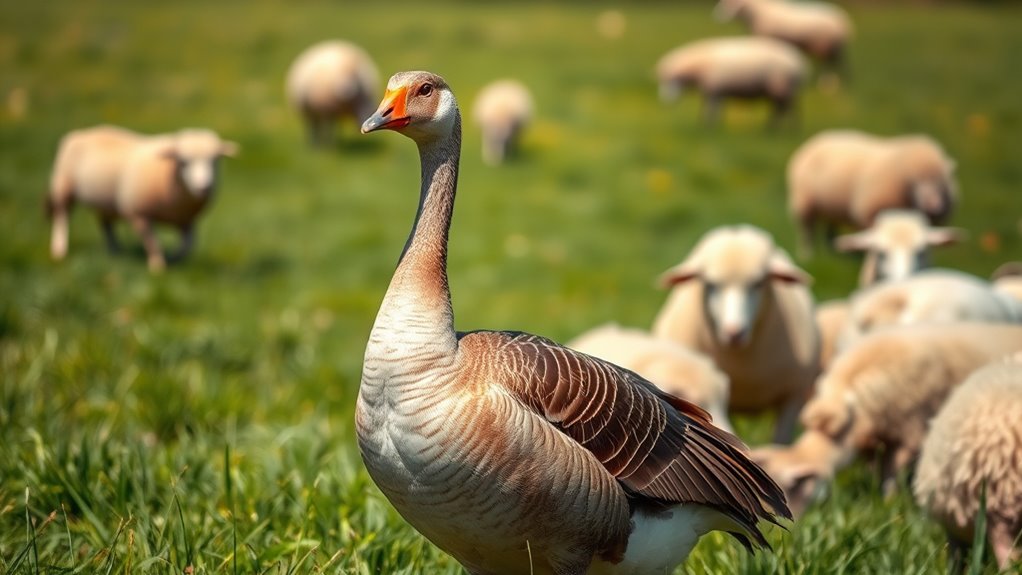
Imprinting and bonding play a significant role in how guard geese respond to their environment, particularly in terms of territorial behavior. Geese instinctively select nesting sites that offer resources and protection, usually near water.
During breeding season, they become fiercely territorial, displaying aggressive behavior to defend their nests and goslings. You'll notice them using loud honks and wing flaps to ward off intruders, with males standing guard nearby. Their preference for open areas allows them to monitor potential threats effectively.
Beyond nesting, geese work together to protect their flock, sounding alarms and forming defensive postures. This strong social loyalty and vigilant nature make them excellent guardians for your livestock against smaller predators.
Choosing the Right Breed for Guarding
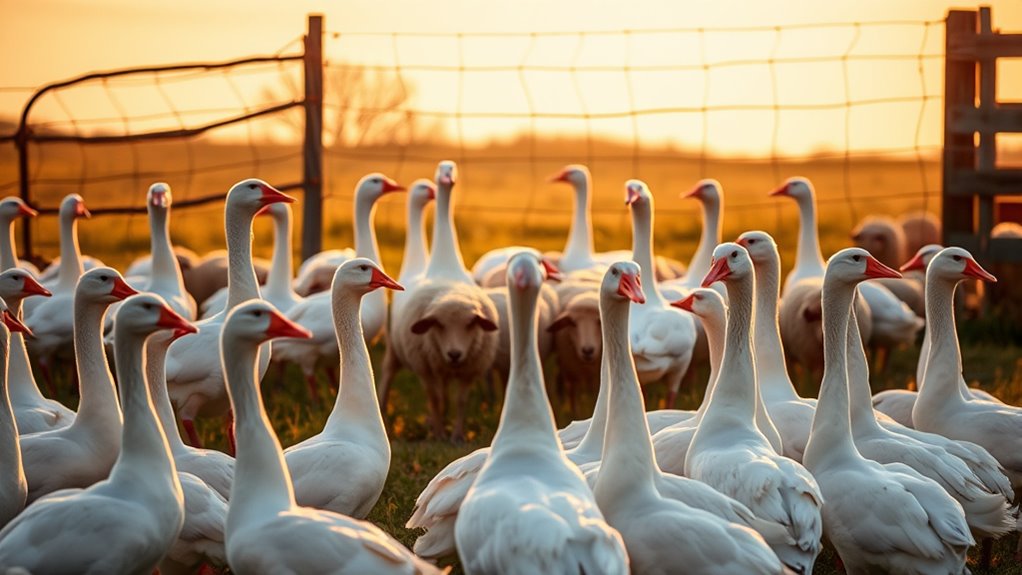
Selecting the right breed of goose for guarding your livestock can significantly enhance protection against potential predators. Different breeds exhibit varying levels of aggression and alertness, making breed selection crucial.
For larger properties, consider African geese; their size intimidates predators. If loud vocalization is your priority, Chinese geese excel at sounding alarms with their honking. For compact areas, smaller breeds like Egyptian geese can be effective too.
Keep in mind the temperament of the breed—some, like Sebastopol geese, are more docile. Additionally, breeds such as Tufted Romans are known for their loud honking and territorial nature, making them excellent guards.
Ultimately, choose a breed that meets your specific needs while ensuring robust protection for your livestock.
Limitations and Risks of Using Geese as Guardians

Although geese can serve as effective alarm systems, they've significant limitations and risks that you should consider before relying on them for livestock protection.
Geese are prey animals, often prioritizing their safety over defending other animals, especially against larger predators like coyotes. A single goose won't provide adequate protection; you'll need multiple geese for better coverage.
Their effectiveness drops at night due to poor visibility. Additionally, geese can get aggressive during mating season, potentially harming smaller birds.
Without proper fencing, they might wander off, losing focus on guarding. Remember, while geese are noisy alert systems, they may also disturb neighbors and create conflicts with other livestock if not managed well.
Frequently Asked Questions
How Do Geese Communicate With Each Other During Guarding?
Geese communicate with each other using loud honking to alert their flock of potential threats.
You'll notice their vocalizations change depending on the situation, signaling danger or calling others to gather.
They also rely on visual cues, using body language to express their feelings and intentions.
When grazing, they stay close together, enhancing their vigilance and social cohesion, which helps them effectively coordinate their responses to any perceived threats.
What Age Should Geese Start Guarding Livestock?
Geese generally gain guarding greatness around six months old.
At this age, they're more assertive and develop a natural watchdog mentality. You'll notice they start forming strong bonds with their flock, enhancing their protective instincts.
By then, they've also matured enough to effectively spot potential threats.
Can Geese Coexist With Other Livestock Species?
Yes, geese can coexist with other livestock species, but you'll need to make some adjustments.
Ensure your coop has enough space, with at least 5-8 square feet per goose and 20 square feet outdoors. Since geese are social creatures, it's best to keep them in pairs or groups.
Monitor their interactions closely, as they can be aggressive if not raised together. Also, consider their noise levels and housing needs to maintain harmony.
How Much Space Do Geese Need for Effective Guarding?
Did you know that each goose needs at least 8 square feet of floor space in their shelter?
For effective guarding, you should ensure that their shelter is at least 8' x 10' to maintain their comfort.
Additionally, don't forget about ventilation and bedding; a clean environment is crucial.
Geese thrive in social settings, so always keep more than one together for optimal guarding effectiveness.
This way, they'll feel secure and alert to any potential threats.
What Are the Signs of an Aggressive Goose?
When you encounter an aggressive goose, look for specific signs.
You'll notice loud honking or hissing, which signals a warning. The goose may adopt a threatening posture, lowering its head and spreading its wings to appear larger.
Watch for sudden charging behavior, especially if it approaches with its head down. If you see rapid head movements or wing flapping, it's best to keep your distance and avoid provoking the bird further.
Conclusion
Incorporating geese as your livestock guardians isn't just a quirky idea; it's like unleashing a feathered army of vigilant sentinels! With their natural instincts and fierce territorial behavior, these noble birds can transform your farm into an impenetrable fortress. Sure, there are some quirks and challenges, but who wouldn't want a gaggle of honking protectors patrolling the fields? So, embrace the goose guarding revolution, and watch your livestock thrive under their watchful eyes!




